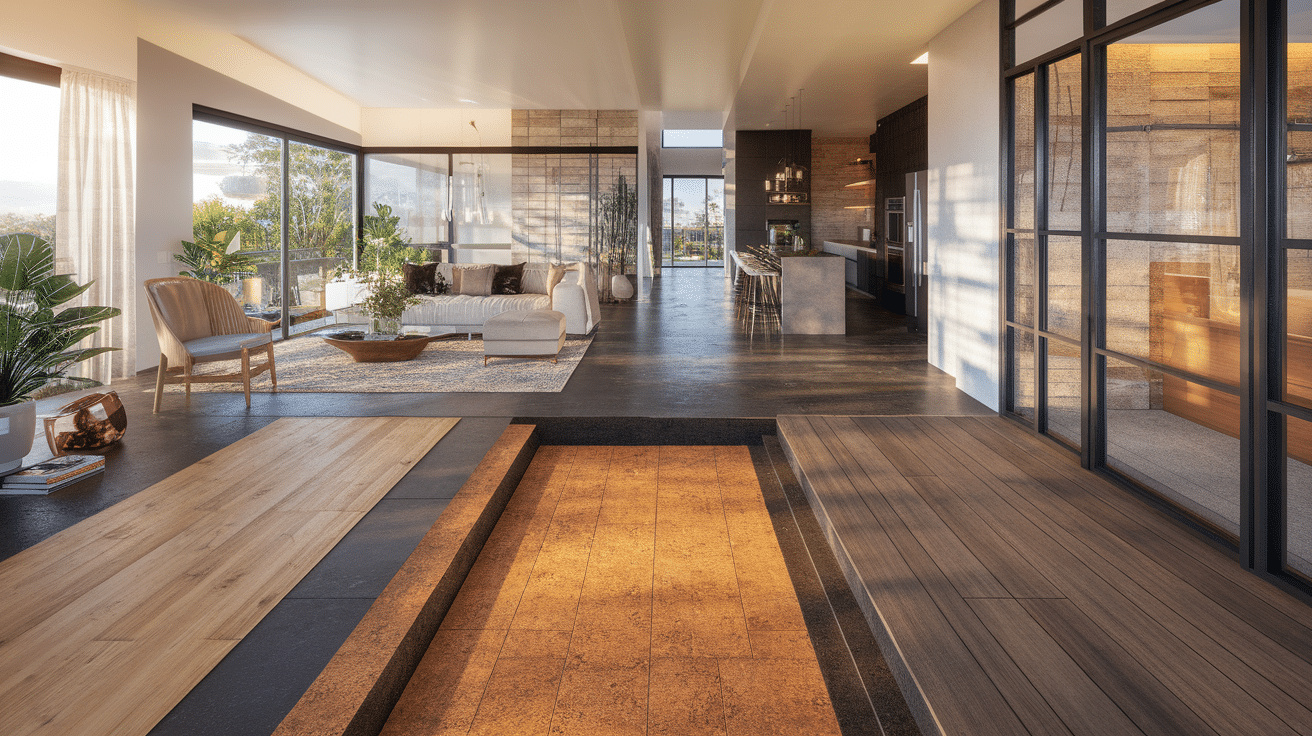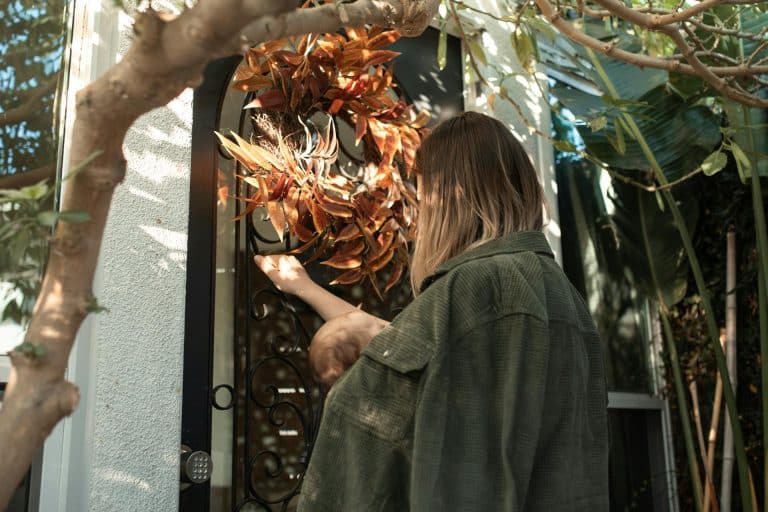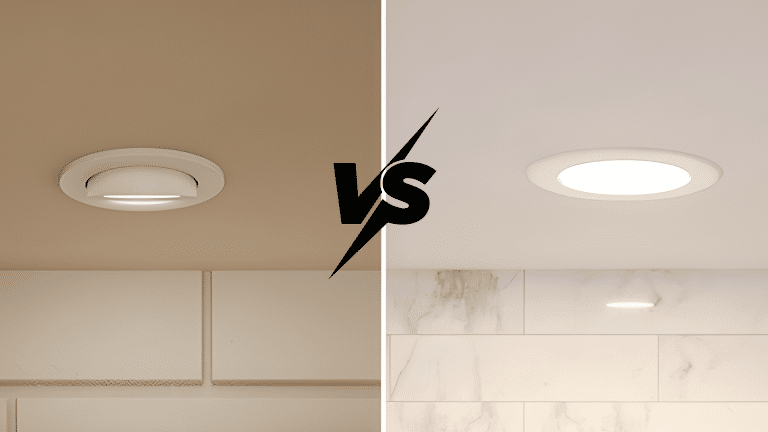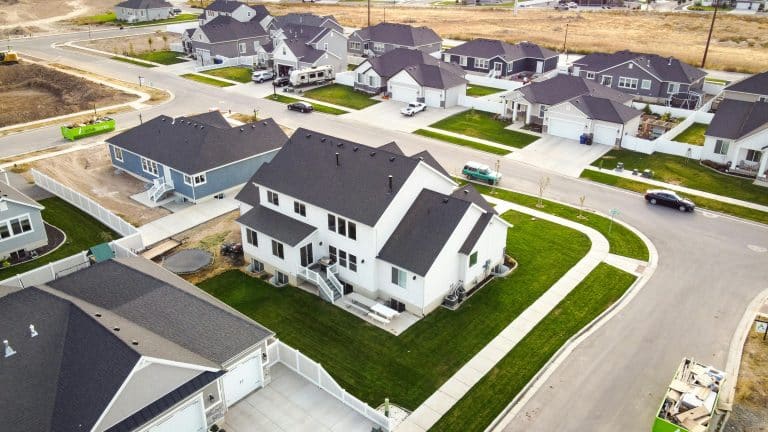Uplift Your Interiors with Innovative Alternative Flooring
Home floors need not be boring. Are you tired of the same old carpets and hardwood options that everyone else has? You’re not alone. Many homeowners want something different but don’t know where to start.
Good news! Many fresh flooring choices can make your home stand out. From cork to bamboo to concrete, these options offer both style and function.
By reading this guide, you’ll learn about cost-effective alternatives that are easy to clean, last longer, and look better than standard options. Your guests will notice the difference right away.
Ready to find the perfect floor for your home? Let’s examine some smart options that will change your perception of your living space.
Benefits of Alternative Flooring
1. Sustainability: Using floor materials that grow quickly and can be harvested without harm to the environment.
- Bamboo: Regrows in 5-7 years vs. decades for hardwood trees
- Cork: Harvested from bark without killing trees
2. Durability: The ability of flooring to withstand daily wear and maintain its appearance over time.
- Porcelain tile: Scratch, water, and stain resistant
- Concrete: Withstands pets, kids, spills; can last 50+ years with proper sealing
3. Cost-Effectiveness: Flooring options that provide good value while costing less than traditional materials.
- Laminate: Half the price of real wood; DIY-friendly
- Peel-and-stick tiles: Fraction of ceramic/stone cost; simple installation
4. Design Versatility: The range of styles, colors, and patterns available in alternative flooring.
- Luxury vinyl: Realistic wood/stone look; comes in planks, tiles, sheets
- Cork: Available in multiple shades from cream to brown
Top Alternative Flooring Options
1. Bamboo Flooring
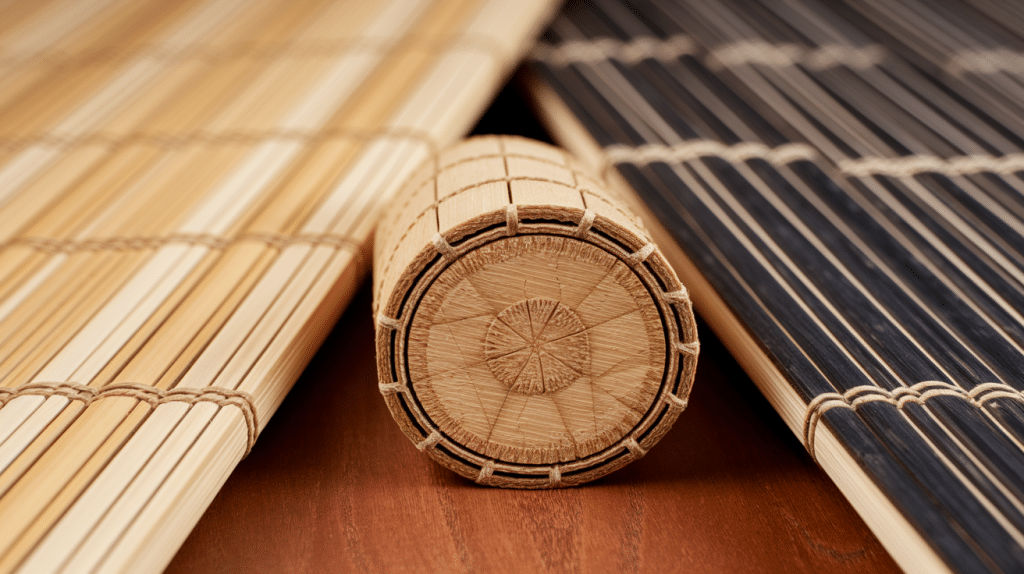
What it is: A grass-based material that looks like wood but grows much faster.
- Made from a plant that regrows in 5-7 years
- Comes in natural, carbonized (darker), and strand-woven types
- Hardness varies by type (strand-woven is hardest)
2. Cork Flooring
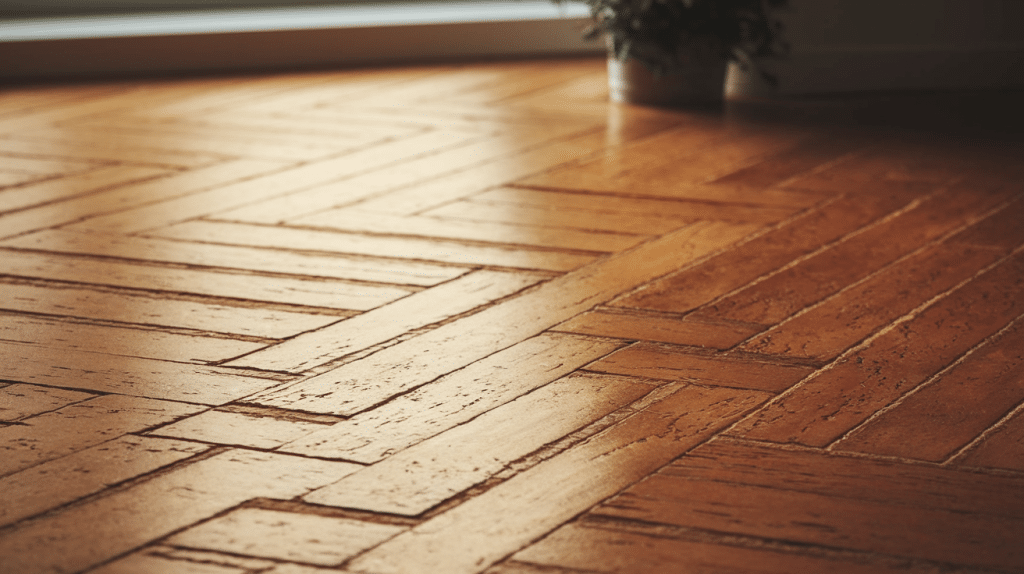
What it is: Natural material made from tree bark that grows back.
- Soft and warm underfoot
- Helps with sound control between floors
- Provides natural insulation
- Comes in tiles or planks
3. Laminate Flooring
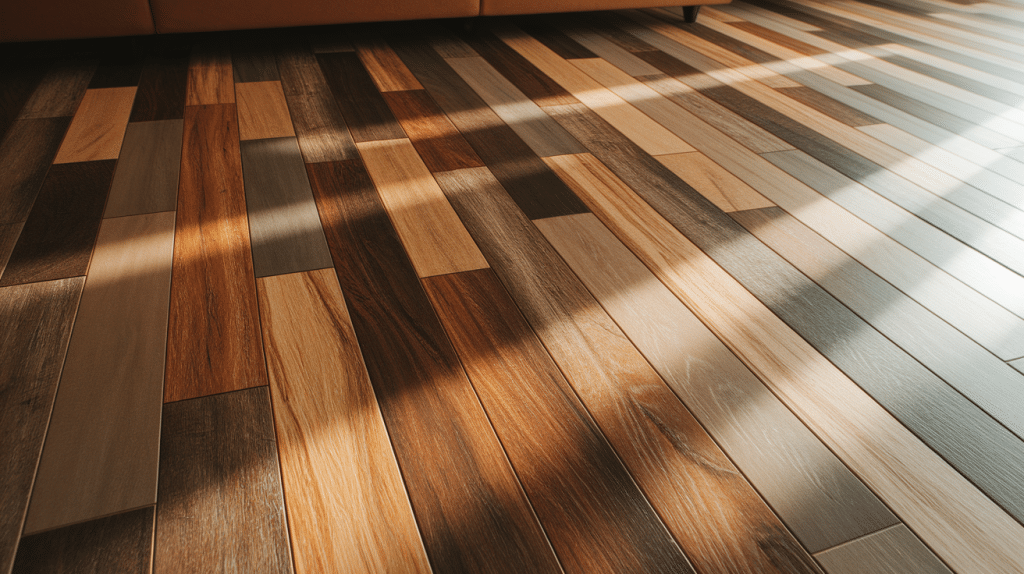
What it is: A Layered product with a wood-look image on a fiberboard core.
- Much cheaper than real wood
- DIY-friendly click-lock installation
- Many styles that look like wood or stone
- Resists scratches and fading
4. Luxury Vinyl Tile (LVT) and Plank (LVP)
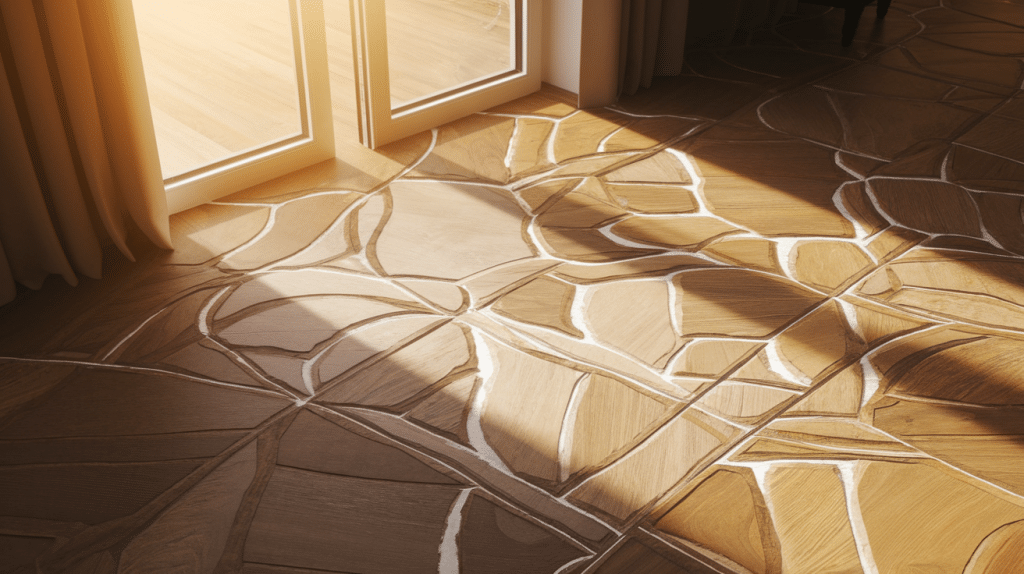
What it is: Synthetic flooring made of multiple layers with realistic images.
- 100% waterproof options available
- Works in any room, including bathrooms
- Very durable and scratch-resistant
- Comes in wood, stone, and tile looks
5. Concrete Flooring
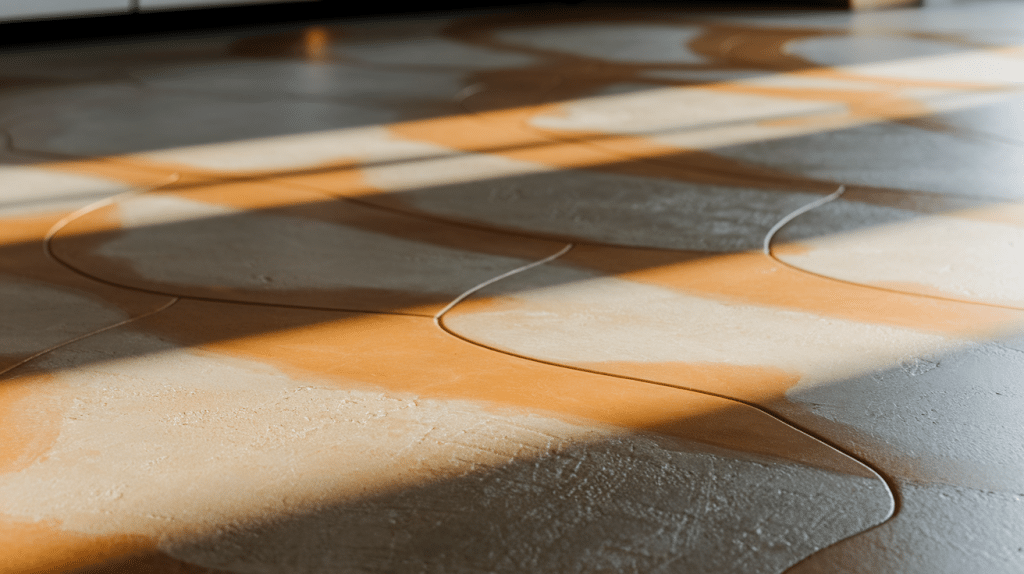
What it is: Finished concrete slab used as the final floor surface.
- It can last a lifetime with proper care
- Can be stained, polished, or stamped
- Works with radiant heating systems
- Very low maintenance
5 Factors to Consider When Choosing Alternative Flooring
1. Installation Requirements: Choose click-lock systems for easy DIY projects without special tools. Consider whether your subfloor needs preparation before installation. Factor in acclimation time – most materials need 24-72 hours in your home first.
2. Maintenance Needs: Check if the flooring needs special cleaners or regular resealing. Consider water resistance if installing in kitchens, bathrooms, or basements. Look for scratch resistance if you have pets or high-traffic areas.
3. Environmental Impact: Look for certifications like FSC for wood products or FloorScore for indoor air quality. Consider locally sourced materials to reduce transportation emissions. Check if the material can be recycled or will biodegrade at the end of life.
4. Budget Constraints: Compare total costs, including underlayment, adhesives, and installation. Factor in the expected lifespan—cheaper options often need replacing sooner. Consider the impact of resale value when selecting materials for long-term investments.
5. Compatibility with Home Design: Bring home samples to see materials in your actual lighting conditions. Consider transitions between rooms and how materials will flow together. Think about comfort underfoot, especially in rooms where you stand frequently.
Installation Tips for Alternative Flooring
- Check your subfloor for levelness – fix any spots that differ by more than 3/16 inch over 10 feet before installing any new flooring.
- Remove the old flooring completely and clean the subfloor thoroughly—even small debris can cause issues with your new floor over time.
- Let all flooring materials sit in your home for at least 48 hours before installation to adjust to your home’s temperature and humidity.
- For DIY projects, consider starting with peel-and-stick vinyl, laminate, or floating luxury vinyl, as they require fewer special tools than other options.
- Measure your room multiple times and buy 10% extra material to account for cuts, waste, and future repairs.
- Use proper safety gear, including knee pads, eye protection, and a dust mask, especially when cutting materials.
- Work from multiple boxes of flooring at once to mix slight color variations for a more natural look.
- Always follow the manufacturer’s instructions for specific spacing requirements – most floors need expansion gaps around the edges.
Maintenance and Care for Alternative Flooring
1. Routine Cleaning
Sweep bamboo and cork floors daily with a soft broom to prevent scratches from dirt.
Clean vinyl and laminate with a damp mop and mild soap – avoid wet mopping that can damage seams.
Use pH-neutral cleaners on concrete floors to prevent etching or damage to sealants. Vacuum cork and other soft floors with a brush attachment, not a beater bar. Wipe up spills on all flooring types right away to prevent staining or swelling.
2. Preventative Measures
Place felt pads under furniture legs to stop scratches on wood-like floors.
Use entrance mats at all doorways to catch dirt before it reaches your floors.
Apply furniture coasters under heavy items on vinyl and laminate to prevent dents. Install blinds or curtains to protect floors from UV fading, especially cork and bamboo.
Maintain indoor humidity between 35% and 55% to prevent expansion and contraction issues.
3. Repair and Restoration
Touch up small scratches on laminate with matching repair kits from hardware stores.
Refinish worn concrete floors with a fresh coat of sealer every 3-5 years. Replace damaged vinyl or laminate planks rather than trying to repair them. Reseal cork floors every 3-5 years to maintain water resistance and appearance.
Sand out minor dents in bamboo with fine-grit sandpaper, then apply matching finish.
5 Common Mistakes with Alternative Flooring
1. Skipping Proper Subfloor Preparation: Many homeowners rush through or completely skip subfloor prep. Small bumps, dips, or moisture issues in the subfloor can lead to uneven wear, loose planks, or bubbling in your new floor. Always take time to level, clean, and check for moisture before installation.
2. Ignoring Acclimation Time: It is costly not to allow flooring materials to adjust to your home’s environment. Materials like bamboo and cork expand and contract with humidity changes. When you skip the 48-72-hour acclimation period, you risk gaps, buckling, or warping after installation.
3. Using Wrong Cleaning Products: Harsh cleaners can strip protective finishes from alternative floors. Many people damage their floors by using vinegar on bamboo, steam mops on laminate, or oil soaps on vinyl. Always follow the manufacturer’s cleaning guidelines for your specific floor type.
4. Forgetting About Humidity Control: Indoor humidity fluctuations can destroy alternative floors, especially natural materials. Without proper humidity control (35-55%), cork can curl, bamboo can cup, and laminate seams can separate. Use humidifiers or dehumidifiers as needed throughout the year.
5. Choosing Based on Price Alone: Selecting the cheapest option often leads to disappointment. Low-quality bamboo may dent easily, thin vinyl can tear, and budget laminate might show wear quickly. Focus on value rather than just initial cost to avoid premature replacement expenses.
Conclusion
Choosing the right floor changes the feel of your whole home. From the eco-friendly bamboo and cork to tough porcelain and concrete, each option has its strengths. The key is to match your needs with the right material.
Think about how you use each room, what matters most to you, and how much care you want to give your floors. Take time to check samples in your own home’s light. Talk to others who have the floors you like.
With good planning and care, your new floors will serve you well for years. They’ll save you money and look good doing it.
Ready to start? Begin with one room, learn what works, and move forward from there. Your ideal floor is out there – now you know how to find it!

